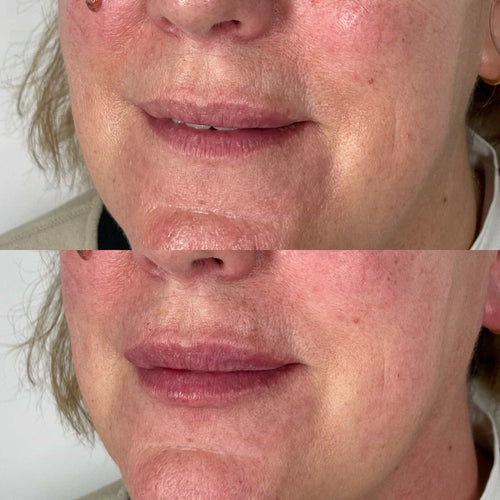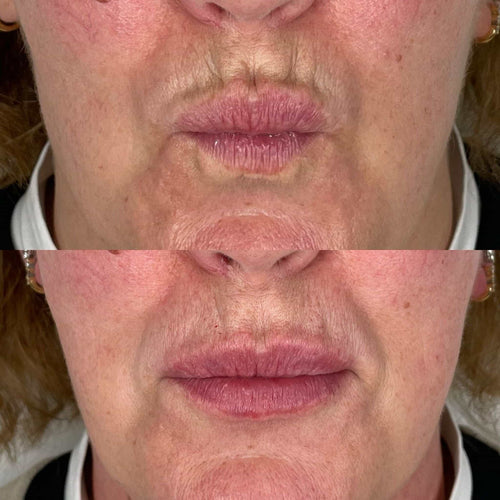Book a Dermal Filler Appointment with Dr. Laura Geige Today
Non-Invasive Solutions

Topical Creams and Serums
Nasolabial folds, those creases that run from the nose to the corners of the mouth, are a natural part of aging. They deepen as facial skin loses elasticity and fat volume diminishes. While surgical procedures can address severe cases, many people seek non-invasive solutions for a subtle improvement in appearance.
Topical creams and serums have become increasingly popular due to their convenience and accessibility. However, it’s important to understand that these products work by stimulating collagen production and hydrating the skin, rather than directly filling the folds.

Here’s a closer look at some common ingredients found in anti-aging topical products:
-
Hyaluronic Acid:** A powerful humectant that attracts and retains moisture, plumping up the skin and reducing the appearance of wrinkles.
-
Retinoids:** Vitamin A derivatives that increase cell turnover, promoting collagen production and smoothing fine lines. They can cause dryness and irritation initially, so start with a low concentration and gradually increase usage.
-
Peptides:** Chains of amino acids that signal the skin to produce more collagen and elastin, improving firmness and elasticity.
While topical creams can offer some improvement, it’s important to manage expectations. Results are gradual and may not be dramatic. Consistency is key, as these products need time to work effectively.
Consider combining topical treatments with other non-invasive options for a more comprehensive approach:
-
Chemical Peels: Exfoliate the top layer of skin, stimulating collagen production and revealing brighter, smoother skin.
-
Microneedling: Uses tiny needles to create micro-injuries in the skin, triggering collagen production and improving texture.
-
Laser Treatments:** Can target specific areas of concern, stimulating collagen production and reducing the appearance of wrinkles.
Consulting with a board-certified dermatologist or plastic surgeon can help determine the best course of treatment for your individual needs and goals.
Dermal Fillers
Deep nasolabial folds are a common sign of aging that can make the face appear tired and aged. Fortunately, there are non-invasive solutions available to help soften these lines and restore a more youthful appearance.
Dermal fillers are one of the most popular non-invasive treatments for deep nasolabial folds. These fillers are made of hyaluronic acid, a naturally occurring substance in the body that helps to hydrate and plump the skin. When injected into the nasolabial folds, dermal fillers can add volume and smooth out the lines.
The treatment process is relatively simple and quick. A topical anesthetic is applied to numb the area, and then the filler is injected using a fine needle. Most people experience minimal discomfort during the procedure.
Results are typically visible immediately after treatment and can last for several months to a year depending on the type of filler used and individual factors like skin elasticity and lifestyle.
Different types of hyaluronic acid fillers offer varying levels of consistency, allowing practitioners to tailor treatment to the depth and severity of the nasolabial folds. Some fillers are specifically designed for volumizing deeper folds, while others provide a more subtle lift.
It is important to consult with a qualified and experienced practitioner who can assess your individual needs and recommend the best type of filler and treatment plan.
Schedule a Consultation for Dermal Fillers with Dr. Laura Geige Today
In addition to dermal fillers, other non-invasive solutions for deep nasolabial folds include:
* **Radiofrequency treatments:** These treatments use radio waves to heat the deeper layers of skin, stimulating collagen production and improving skin elasticity.
* **Microneedling:** This treatment involves using tiny needles to create micro-injuries in the skin, which stimulates collagen growth and can help improve the appearance of wrinkles and folds.
Book Your Dermal Filler Appointment with Dr. Laura Geige Today
Choosing the best treatment option will depend on factors such as your skin type, desired outcome, and budget.
Minimally Invasive Procedures
Radiofrequency Treatments
Nasolabial folds, those creases that run from the bottom of your nose to the corner of your mouth, are a common sign of aging. While genetics play a role, volume loss and skin laxity are major contributors.
Minimally invasive procedures offer a way to address these concerns without going under the knife.
One popular option is **radiofrequency (RF)** therapy.
Radiofrequency technology uses energy waves to heat the deep layers of the skin, stimulating collagen production and tightening the underlying tissue.
This can help to fill in wrinkles and folds, improving their appearance.
How does RF treatment work for nasolabial folds?
During an RF treatment session, a specialized device is used to apply radiofrequency energy to the targeted area.
The heat generated by the RF energy stimulates fibroblasts, the cells responsible for producing collagen.
Collagen is a protein that provides structure and support to the skin, making it firm and elastic.
As collagen production increases, the skin tightens and wrinkles become less prominent.
RF treatment can also help to stimulate elastin production, another protein that contributes to skin elasticity.
The combined effects of increased collagen and elastin result in a smoother, firmer appearance for the nasolabial folds.
Benefits of RF Treatment for Nasolabial Folds:
• Minimally invasive:** RF treatments are performed in-office with minimal downtime.
• **Safe and effective:** Radiofrequency energy is a well-established technology with a proven track record of effectiveness for skin tightening and wrinkle reduction.
• **Natural-looking results:** RF treatment helps to stimulate your body’s own collagen production, resulting in a subtle and natural-looking improvement in the appearance of nasolabial folds.
• Long-lasting effects: While results are not permanent, they can last for several months to a year or more with regular maintenance treatments.
It is important to consult with a qualified dermatologist or plastic surgeon to determine if RF treatment is right for you and to discuss your specific expectations and goals.
They will assess your skin condition and facial anatomy to create a customized treatment plan.
Microneedling
Minimally invasive procedures offer a range of options for addressing deep nasolabial folds, also known as smile lines, which are wrinkles that extend from the bottom of your nose to the corners of your mouth.
One increasingly popular minimally invasive procedure for treating these wrinkles is microneedling. This technique involves using a device with tiny needles to create controlled punctures in the skin.
These micro-injuries stimulate the body’s natural healing process, prompting collagen and elastin production. Collagen is a structural protein that provides firmness and elasticity to the skin, while elastin allows the skin to stretch and recoil.
By boosting these proteins, microneedling helps to fill in the deeper lines and folds, resulting in a smoother and more youthful appearance.
Microneedling can be performed on various parts of the face, including the nasolabial folds. During the procedure, topical anesthetic is applied to numb the area.
The microneedling device is then gently rolled over the targeted skin, creating the microscopic punctures. Depending on the severity of the wrinkles and individual skin type, multiple sessions may be necessary for optimal results.
Other minimally invasive procedures that can effectively address deep nasolabial folds include:
-
Dermal fillers
-
Botox
-
Chemical peels
Surgical Options
Facelift Surgery
Deep nasolabial folds, those prominent creases that run from the sides of the nose to the corners of the mouth, can make one appear older and more tired. While non-surgical treatments like fillers can temporarily plump up the area, a facelift can offer a more long-lasting solution.
Here’s a detailed look at how a facelift addresses deep nasolabial folds:
Understanding Facelift Surgery
A facelift (rhytidectomy) is a surgical procedure designed to rejuvenate the face and neck. It involves lifting and tightening the underlying tissues that support the skin, resulting in a smoother, more youthful appearance.
Targeting Nasolabial Folds During Facelift
- Direct Tissue Lift: The surgeon elevates and re-drapes the underlying facial muscles (particularly the zygomaticus major muscle, which contributes to nasolabial fold formation) along with the overlying skin. This lift directly addresses the excess skin and sagging that contribute to the appearance of deep folds.
- Smoother Skin Contours: By tightening the underlying tissues, a facelift creates smoother contours on the face, minimizing the prominence of nasolabial folds.
Benefits Beyond Nasolabial Folds
A facelift can also address:
- Jawline Definition: It tightens the skin and muscles in the jawline area, resulting in a more defined and sculpted appearance.
- Neck Bands (Turkey Neck): It reduces the appearance of loose skin and fat deposits on the neck, leading to a smoother, more toned neckline.
- Forehead Wrinkles: Some facelift techniques incorporate forehead lift elements, smoothing out wrinkles in the forehead and between the eyebrows.
Important Considerations
It’s crucial to have a thorough consultation with a board-certified plastic surgeon who specializes in facelifts. They will assess your individual needs, facial anatomy, and desired outcomes to determine if a facelift is the right option for you.
Fat Transfer
Deep nasolabial folds, those creases that run from the sides of your nose to the corners of your mouth, are a common sign of aging. They can contribute to a tired or gaunt appearance.
Fortunately, several surgical options exist to address these folds and restore a more youthful look.
- Facial Implants:
- Facelift (Rhytidectomy):
- Fat Transfer:
Facial implants, often made from silicone or porous polyethylene, can be surgically placed beneath the skin to add volume to the cheeks and midface. This helps fill in the nasolabial folds, making them less prominent.
A facelift addresses sagging skin and underlying muscle tissue in the lower face and neck. While not solely focused on the nasolabial folds, a facelift can significantly improve their appearance by tightening the surrounding tissues.
This technique involves harvesting fat from areas like the abdomen or thighs and transferring it to the cheeks and nasolabial folds. The injected fat adds volume and softens the appearance of the folds, providing a more natural look than implants.
Each surgical option has its own advantages and disadvantages, and the best choice for you will depend on factors such as your age, skin elasticity, the severity of your nasolabial folds, and your personal preferences.
It’s crucial to consult with a qualified and experienced plastic surgeon to discuss your goals and determine the most suitable treatment plan.
In addition to surgical options, non-surgical treatments like dermal fillers can temporarily reduce the appearance of nasolabial folds. These fillers provide instant results but require repeat injections for maintenance.
Highland Spring Magazine K’s P Rules Cakes Emily Patricia Fae
- Sculptra Surrey – Collagen Stimulation Therapy Near Hersham, Surrey - December 29, 2024
- How Do You Hide Deep Nasolabial Folds? - December 14, 2024
- Gummy Smile Treatment – Gum Contouring Near Croydon, Surrey - December 11, 2024
